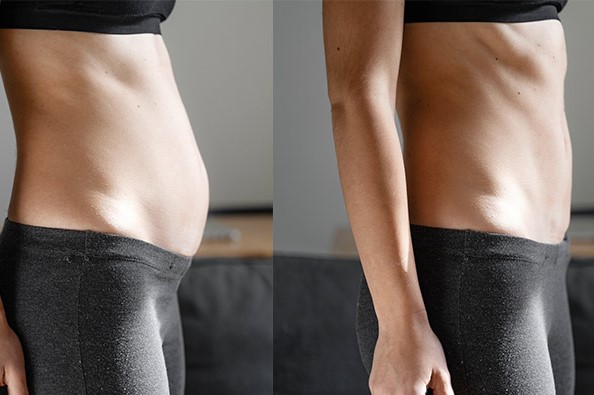
What it is and how to recognise abdominal diastasis
Abdominal diastasis affects around 30% of women after childbirth, yet it is still little talked about. Often underestimated or confined to a cosmetic problem, abdominal diastasis is in fact a functional problem in the first place, which is why it must be dealt with in the correct way
What is abdominal diastasis?
Abdominal diastasis is defined as the enlargement and excessive separation of the central rectus abdominis muscles in a longitudinal direction.
This musculature, which is one of the main muscles of the anterior abdominal wall, consists of a right rectus abdominis muscle and a left rectus abdominis muscle, held together by a thin band of connective tissue, the so-called linea alba, which runs from below the sternum to the pelvic bones, joining the two rectus abdominis muscles and allowing continence of the internal viscera.
This fascia is very strong, but not very elastic, so when, for some reason, it becomes brittle or thin, it is difficult for it to return to its original condition spontaneously.
This is why we talk about abdominal diastasis, a problem that can have different degrees depending on whether the two rectus abdominis muscles are more or less distant.
Abdominal diastasis, in particular, depending on its size, is classified in:
- mild diastasis, less than 3 centimetres;
- moderate diastasis, between 3 and 5 centimetres;
- severe diastasis, greater than 5 centimetres.
Why does abdominal diastasis occur after childbirth?
The main reason why abdominal diastasis can occur is pregnancy, especially twin pregnancy.
The weight and internal pressure due to the growth of the fetus during the nine months, together with the hormonal changes typical of this phase of a woman’s life, cause the rectus abdominis muscles to stretch and the connective tissues to thin, leading to the separation of the two rectus abdominis muscles.
Causes of abdominal diastasis in men
Other factors that can affect the appearance of the problem are significant weight gain.
Men can also be subject to abdominal diastasis.
In this case, the most frequent causes are, in addition to weight gain
- muscle laxity
- obesity associated with a high percentage of abdominal fat;
- major weight loss, for example in people who undergo bariatric surgery.
The consequences of diastasis
Contrary to what is often thought, the consequences are not only aesthetic, but above all functional.
The most visible consequences are undoubtedly
- the appearance of a longitudinal indentation along the abdomen;
- the impossibility of having a flat stomach;
- the loss of the waistline.
But it is the consequences that are less visible from the outside that should not be underestimated.
If the abdominal fascia formed by the muscles loses its function of containing and holding the abdominal viscera in place, the viscera can protrude (i.e. protrude from their natural location), giving rise to abdominal hernias of varying degrees and extent.
In a good percentage of cases, diastasis is in fact associated with an umbilical hernia or an epigastric hernia (located in the upper part of the abdomen), which can, in some cases, lead to serious complications.
The symptoms
The ‘functional’ symptoms with which abdominal diastasis can manifest itself are:
- bloating, especially postprandial
- abdominal pain
- digestive difficulties;
- back pain, even in the pelvis;
- incontinence.
Abdominal diastasis: diagnosis
To diagnose abdominal diastasis, a specialist examination is necessary, which may be accompanied by an ultrasound scan of the abdominal wall.
Once the presence of abdominal diastasis has been detected, it is essential to accurately assess the real distance between the muscles, one of the parameters on the basis of which the correct therapeutic approach is then established.
How to treat it
The solution to abdominal diastasis is surgical and requires specific surgical skills.
The surgical intervention varies depending on the degree. In the case of mild to moderate diastases, an abdominoplasty is performed, with simultaneous repositioning of the rectus abdominis muscles.
In practice, the two muscles that have moved apart are brought closer together and joined with special so-called ‘double-breasted’ sutures.
If, on the other hand, the degree is severe, or if the muscles are not elastic enough to be brought back together, it becomes necessary to insert a biocompatible resorbable mesh that acts as a connection, favouring the rejoining of the muscles and re-establishing the function of containing the internal organs.
Discharge is usually 2-3 days after the operation.
In the post-operative period, it is recommended to wear a supportive elastic girdle for about 1 month.
Are exercises for abdominal diastasis useful?
Physical activity to strengthen the abdominal muscles does not help to improve, but in some cases can even worsen and lead to hypertrophy of the muscles that already work poorly.
Read Also:
Emergency Live Even More…Live: Download The New Free App Of Your Newspaper For IOS And Android
Postpartum Psychosis: Knowing It To Know How To Deal With It
General Or Local Anaesthesia? Discover The Different Types


